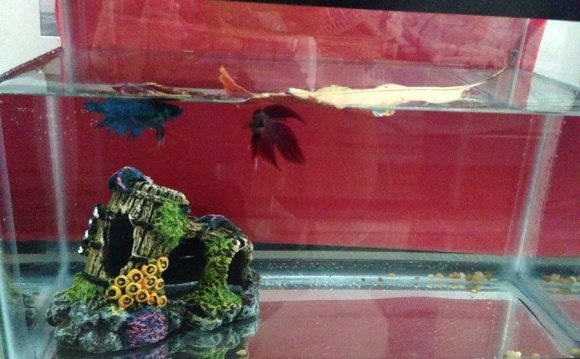
 Visit a reputable breeder. Pet stores are often unsanitary and sell Betta fish too old to breed. Visit a breeder and ask a lot of questions. Try to determine how well the breeder understands the genetics of its Betta fish. If she seems knowledgeable, ask for suggestions about picking good pairs.
Visit a reputable breeder. Pet stores are often unsanitary and sell Betta fish too old to breed. Visit a breeder and ask a lot of questions. Try to determine how well the breeder understands the genetics of its Betta fish. If she seems knowledgeable, ask for suggestions about picking good pairs.
- While it is tempting to pick out fish that are bigger and brighter, these are often older, which will make it more difficult to breed them.
- Akarensis
- Albimarginata
- Bellica
- Coccina
- Foerschi
- Picta
- Pugnax
- Splendens
- Unimaculata
- Waseri
- Be sure that the male is at least as large as its female companion, preferably a bit larger.
- For optimal results when breeding, it is typically best to mate two fish with similar color patterns. Try to purchase four fish that are of a similar breed, possibly even of the same family.
 Part 2
Part 2
- Keep them separated. Bettas are an aggressive species. With some exceptions, Betta fish have difficulty being in a bowl together. In general, you should keep them in separate aquariums. When you are prepared to breed them, it is imperative that it be in a tank that is at least 20-gallons large, with no other fish.
- Wild Betta breeds are less aggressive and can often be kept together. Domesticated species were typically bred to be fighting fish and are thus highly aggressive. Wild breeds are more sedate, but you should still be careful when introducing wild bettas to each other.
- Females Betta fish are also less aggressive than their male counterparts. They will chase other bettas, but they are less likely to bite and seriously injure each other. You can keep as many as three female Betta fish in a single tank, though you should monitor their behavior to ensure that their aggression does not escalate.
- Male Betta fish can be kept in a large tank with fish of other species, especially if they have different color patterns. When you are ready to breed your bettas, however, they will need a separate tank for themselves. Only the male and the female can be in the tank with the fry, and even they can only be there for a brief period of time.
- Fatten up your Betta fish. Your bettas will become more likely to breed when you fatten them up. For about a two-week period, switch from pelleted food to a wide variety of live foods. Try brine shrimp, black worms, tubifex worms, and daphnias. Feed a variety of foods, two to four times a day.
- You can recognize when a female is getting ready to breed because she will get larger. You might even be able to see the eggs growing underneath her skin. Vertical stripes might also appear on her body.
- Well conditioned males, on the other hand, will begin to produce bubble nests.
 These are small collections of bubbles which should accumulate on the top of the water, near the edge of the tank.
These are small collections of bubbles which should accumulate on the top of the water, near the edge of the tank. - Live feed should be available at most pet stores.
- You should aim to feed the fish as much as they can take. If any food remains in the tank after five minutes, you have fed them too much. Clean out any renaming food to prevent contamination of the aquarium.
- Let your Betta fish get to know each other. While conditioning your bettas, place a male and female couple where they can see each other without being able to interact. This can either be in two separate tanks adjacent to one another, or in the same tank, with a glass divider.
- You should move the fish close to each other at around the same time that you begin feeding them more heavily. Doing both of these two things simultaneously will effectively send your bettas the message that they should prepare to mate.
- Put them in the same tank. Place the female betta into the male betta’s tank. The two will likely nip at one another; do not separate them unless it looks like they are causing serious harm. Eventually the male should take the female to the bubble nest where the two will embrace each other until mating is over.
- The mating process will take about an hour or two. The male will take the female to his bubble nest and the female will release eggs into it. The two fish should interact with each other throughout the process. Once it is over, the male will scare the female away.
- Rather than putting the female in the male's tank, you can transfer them both to a new tank. After the breeding process, you will need to remove the male from the aquarium with its fry (baby fish), thus making it possibly advantageous to return him to the tank he is accustomed to. However, the male needs to spend at least a week in the aquarium before the mating process to create a bubble nest in the tank.
- Remove the female immediately after mating. After mating is complete, the male will scare away the female. Remove the female from the tank immediately to prevent further injury. Try to take precautions to prevent infection.
- When you remove the female from the tank with the male, put her in an aquarium that has been treated with a disinfectant like Betamax. She has likely been injured during the mating process and you should do what you can to prevent infection.


Source: www.wikihow.com









